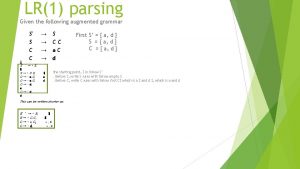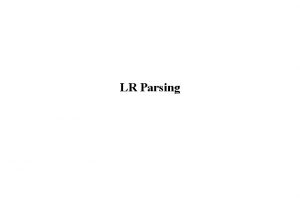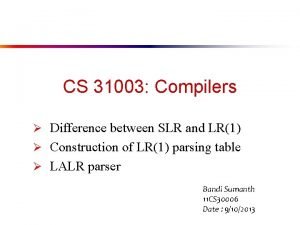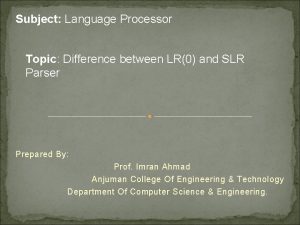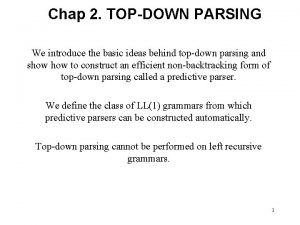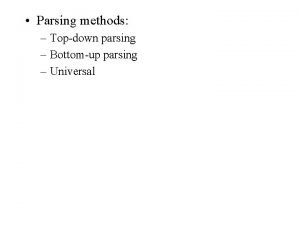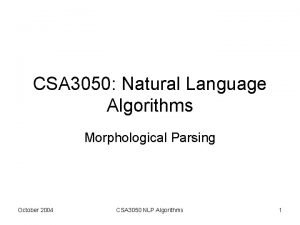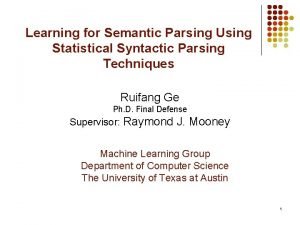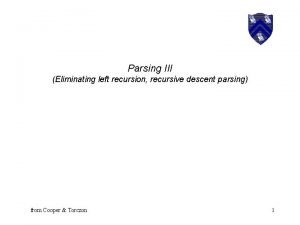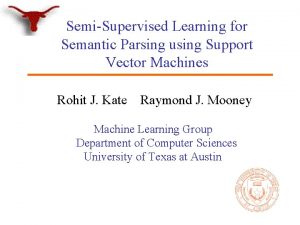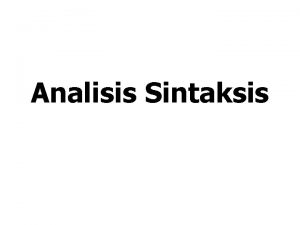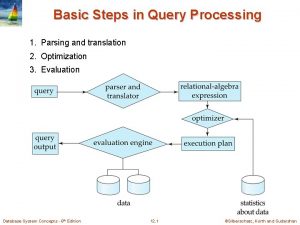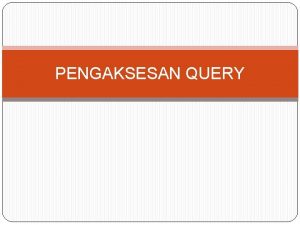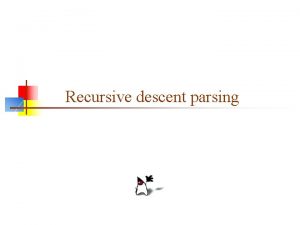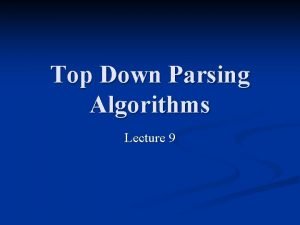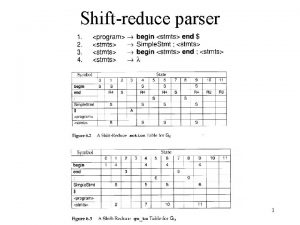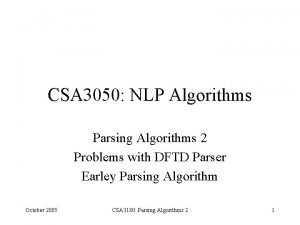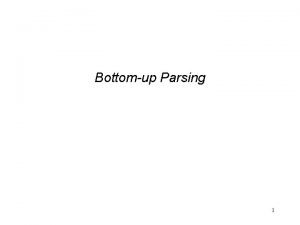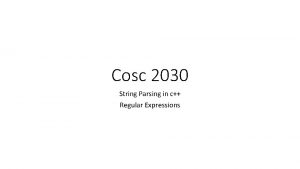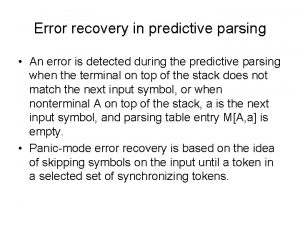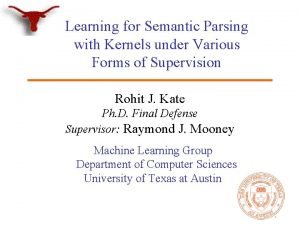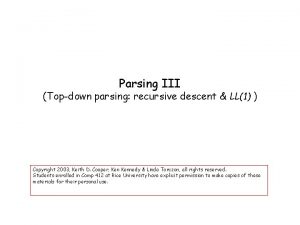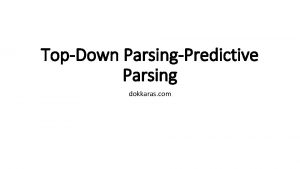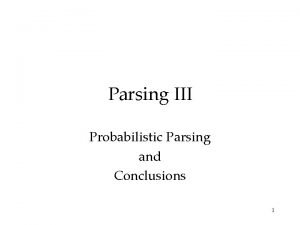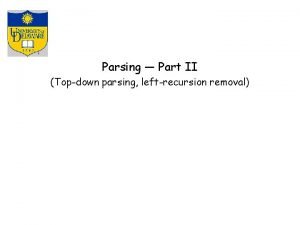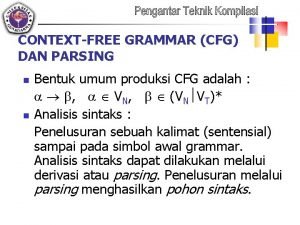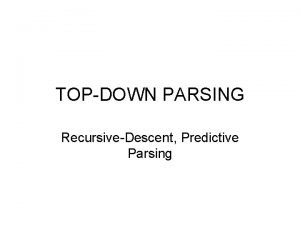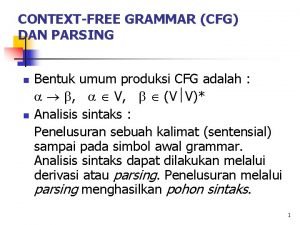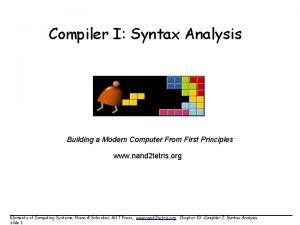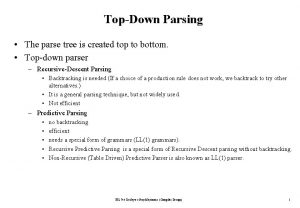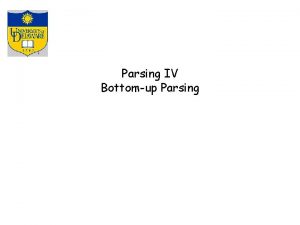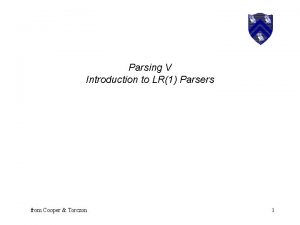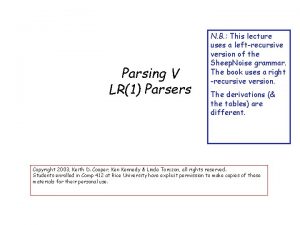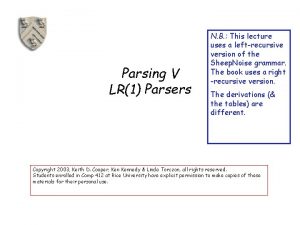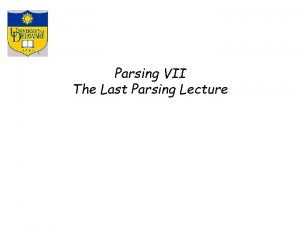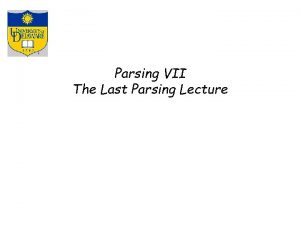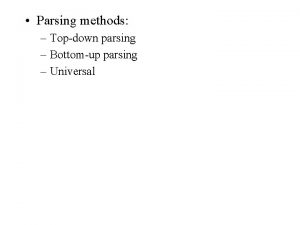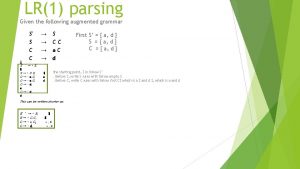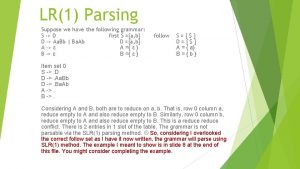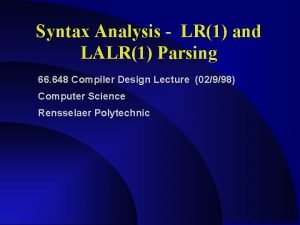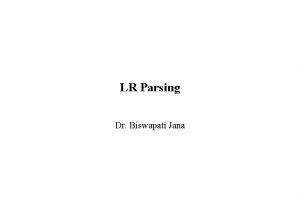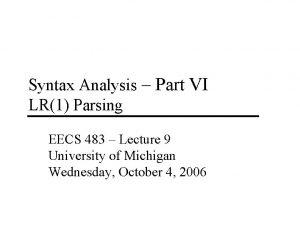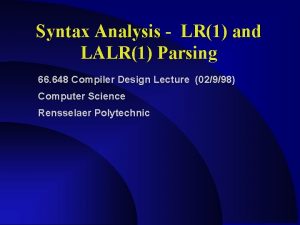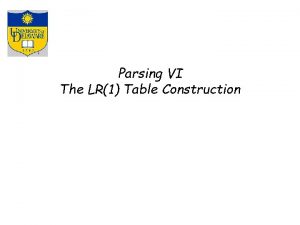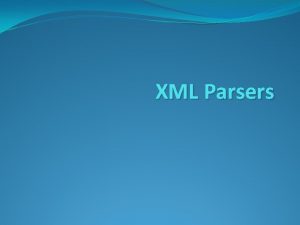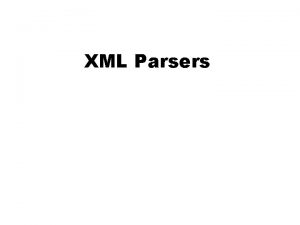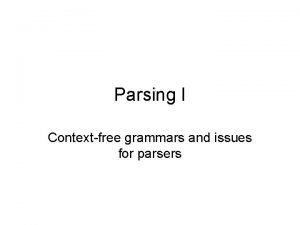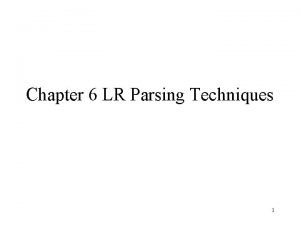Parsing V LR1 Parsers LR1 Parsers LR1 parsers






















![Example From Sheep. Noise Initial step builds the item [Goal • Sheep. Noise, EOF] Example From Sheep. Noise Initial step builds the item [Goal • Sheep. Noise, EOF]](https://slidetodoc.com/presentation_image_h2/1e3f5fbac3b4bc143d15a495cefad698/image-23.jpg)

![Example from Sheep. Noise S 0 is { [Goal • Sheep. Noise, EOF], [Sheep. Example from Sheep. Noise S 0 is { [Goal • Sheep. Noise, EOF], [Sheep.](https://slidetodoc.com/presentation_image_h2/1e3f5fbac3b4bc143d15a495cefad698/image-25.jpg)
![Example from Sheep. Noise S 0 : { [Goal • Sheep. Noise, EOF], [Sheep. Example from Sheep. Noise S 0 : { [Goal • Sheep. Noise, EOF], [Sheep.](https://slidetodoc.com/presentation_image_h2/1e3f5fbac3b4bc143d15a495cefad698/image-26.jpg)
![Building the Canonical Collection Start from s 0 = closure( [S’ S, EOF ] Building the Canonical Collection Start from s 0 = closure( [S’ S, EOF ]](https://slidetodoc.com/presentation_image_h2/1e3f5fbac3b4bc143d15a495cefad698/image-27.jpg)




- Slides: 31

Parsing V LR(1) Parsers

LR(1) Parsers • LR(1) parsers are table-driven, shift-reduce parsers that use a limited right context (1 token) for handle recognition • LR(1) parsers recognize languages that have an LR(1) grammar Informal definition: A grammar is LR(1) if, given a rightmost derivation S 0 1 2 … n– 1 n sentence We can 1. isolate the handle of each right-sentential form i, and 2. determine the production by which to reduce, by scanning i from left-to-right, going at most 1 symbol beyond the right end of the handle of i

LR(1) Parsers A table-driven LR(1) parser looks like Tables can be built by hand However, this is a perfect task to automate

LR(1) Skeleton Parser stack. push(INVALID); stack. push(s 0); not_found = true; token = scanner. next_token(); do while (not_found) { s = stack. top(); if ( ACTION[s, token] == “reduce A ” ) then { stack. popnum(2*| |); // pop 2*| | symbols s = stack. top(); stack. push(A); stack. push(GOTO[s, A]); } else if ( ACTION[s, token] == “shift si” ) then { stack. push(token); stack. push(si); token scanner. next_token(); } else if ( ACTION[s, token] == “accept” & token == EOF ) then not_found = false; else report a syntax error and recover; } report success; The skeleton parser • uses ACTION & GOTO tables • does |words| shifts • does |derivation| reductions does 1 accept • • detects errors by failure of 3 other cases

LR(1) Parsers (parse tables) To make a parser for L(G), need a set of tables The grammar The tables Remember, this is the left-recursive Sheep. Noise; Ea. C shows the rightrecursive version.

Example Parse 1 The string “baa”

Example Parse 1 The string “baa”

Example Parse 1 The string “baa”

Example Parse 1 The string “baa”

Example Parse 2 The string “baa ”

Example Parse 2 The string “baa ”

Example Parse 2 The string “baa ”

Example Parse 2 The string “baa ”

LR(1) Parsers How does this LR(1) stuff work? • Unambiguous grammar unique rightmost derivation • Keep upper fringe on a stack All active handles include top of stack (TOS) Shift inputs until TOS is right end of a handle • Language of handles is regular (finite) Build a handle-recognizing DFA ACTION & GOTO tables encode the DFA • To match subterm, invoke subterm DFA & leave old DFA’s state on stack • Final state in DFA a reduce action New state is GOTO[state at TOS (after pop), lhs] For SN, this takes the DFA to s 1

Building LR(1) Parsers How do we generate the ACTION and GOTO tables? • Use the grammar to build a model of the DFA • Use the model to build ACTION & GOTO tables • If construction succeeds, the grammar is LR(1) The Big Picture • Model the state of the parser • Use two functions goto( s, X ) and closure( s ) Terminal or non-terminal goto() is analogous to Delta() in the subset construction closure() adds information to round out a state • Build up the states and transition functions of the DFA • Use this information to fill in the ACTION and GOTO tables

LR(k) items The LR(1) table construction algorithm uses LR(1) items to represent valid configurations of an LR(1) parser An LR(k) item is a pair [P, ], where P is a production A with a • at some position in the rhs is a lookahead string of length ≤ k (words or EOF) The • in an item indicates the position of the top of the stack [A • , a] means that the input seen so far is consistent with the use of A immediately after the symbol on top of the stack, i. e. , this item is a “possibility” [A • , a] means that the input sees so far is consistent with the use of A at this point in the parse, and that the parser has already recognized , i. e. , this item is “partially complete” [A • , a] means that the parser has seen , and that a lookahead symbol of a is consistent with reducing to A, i. e. , this item is “complete”

LR(1) Items The production A , where = B 1 B 1 B 1 with lookahead a, can give rise to 4 items [A • B 1 B 2 B 3, a], [A B 1 • B 2 B 3, a], [A B 1 B 2 • B 3, a], & [A B 1 B 2 B 3 • , a] The set of LR(1) items for a grammar is finite What’s the point of all these lookahead symbols? • Carry them along to choose the correct reduction, if there is a choice • Lookaheads are bookkeeping, unless item has • at right end Has no direct use in [A • , a] In [A • , a], a lookahead of a implies a reduction by A For { [A • , a], [B • , b] }, a reduce to A; FIRST( ) shift Limited right context is enough to pick the actions

LR(1) Table Construction High-level overview Build the canonical collection of sets of LR(1) Items, I a Begin in an appropriate state, s 0 [S’ • S, EOF], along with any equivalent items Derive equivalent items as closure( s 0 ) b Repeatedly compute, for each sk, and each X, goto(sk, X) If the set is not already in the collection, add it Record all the transitions created by goto( ) This eventually reaches a fixed point 2 Fill in the table from the collection of sets of LR(1) items The canonical collection completely encodes the transition diagram for the handle-finding DFA

Back to Finding Handles Revisiting an issue from last class Parser in a state where the stack (the fringe) was Expr – Term With lookahead of * How did it choose to expand Term rather than reduce to Expr? • Lookahead symbol is the key • With lookahead of + or –, parser should reduce to Expr • With lookahead of * or /, parser should shift • Parser uses lookahead to decide • All this context from the grammar is encoded in the handle recognizing mechanism

Remember this slide from last lecture? Back to x – 2 * y shift here 1. Shift until TOS is the right end of a handle 2. Find the left end of the handle & reduce

Computing FIRST Sets Define FIRST as • If * a , a T, (T NT)*, then a FIRST( ) • If * , then FIRST( ) Note: if = X , FIRST( ) = FIRST(X) To compute FIRST • Use a fixed-point method • FIRST(A) 2(T ) • Loop is monotonic Algorithm halts

Computing Closures Closure(s) adds all the items implied by items already in s • Any item [A B , a] implies [B , x] for each production with B on the lhs, and each x FIRST( a) • Since B is valid, any way to derive B is valid, too The algorithm Closure( s ) while ( s is still changing ) items [A • B , a] s productions B P b FIRST( a) // might be if [B • , b] s then add [B • , b] to s Classic fixed-point method Halts because s ITEMS Worklist version is faster Closure “fills out” a state
![Example From Sheep Noise Initial step builds the item Goal Sheep Noise EOF Example From Sheep. Noise Initial step builds the item [Goal • Sheep. Noise, EOF]](https://slidetodoc.com/presentation_image_h2/1e3f5fbac3b4bc143d15a495cefad698/image-23.jpg)
Example From Sheep. Noise Initial step builds the item [Goal • Sheep. Noise, EOF] and takes its closure( ) Closure( [Goal • Sheep. Noise, EOF] ) So, S 0 is { [Goal • Sheep. Noise, EOF], [Sheep. Noise • Sheep. Noise baa, EOF], [Sheep. Noise • baa, EOF], [Sheep. Noise • Sheep. Noise baa, baa], [Sheep. Noise • baa, baa] }

Computing Gotos Goto(s, x) computes the state that the parser would reach if it recognized an x while in state s • Goto( { [A X , a] }, X ) produces [A X , a] (obviously) • It also includes closure( [A X , a] ) to fill out the state The algorithm Goto( s, X ) new Ø items [A • X , a] s new [A X • , a] return closure(new) Straightforward computation Uses closure ( ) Goto() moves forward
![Example from Sheep Noise S 0 is Goal Sheep Noise EOF Sheep Example from Sheep. Noise S 0 is { [Goal • Sheep. Noise, EOF], [Sheep.](https://slidetodoc.com/presentation_image_h2/1e3f5fbac3b4bc143d15a495cefad698/image-25.jpg)
Example from Sheep. Noise S 0 is { [Goal • Sheep. Noise, EOF], [Sheep. Noise • Sheep. Noise baa, baa], [Sheep. Noise • baa, baa] } Goto( S 0 , baa ) • Loop produces • Closure adds nothing since • is at end of rhs in each item In the construction, this produces s 2 { [Sheep. Noise baa • , {EOF, baa}]} New, but obvious, notation for two distinct items [Sheep. Noise baa • , EOF] & [Sheep. Noise baa • , baa]
![Example from Sheep Noise S 0 Goal Sheep Noise EOF Sheep Example from Sheep. Noise S 0 : { [Goal • Sheep. Noise, EOF], [Sheep.](https://slidetodoc.com/presentation_image_h2/1e3f5fbac3b4bc143d15a495cefad698/image-26.jpg)
Example from Sheep. Noise S 0 : { [Goal • Sheep. Noise, EOF], [Sheep. Noise • Sheep. Noise baa, EOF], [Sheep. Noise • baa, EOF], [Sheep. Noise • Sheep. Noise baa, baa], [Sheep. Noise • baa, baa] } S 1 = Goto(S 0 , Sheep. Noise) = { [Goal Sheep. Noise • , EOF], [Sheep. Noise • baa, baa] } S 2 = Goto(S 0 , baa) = { [Sheep. Noise baa • , baa] } EOF], S 3 = Goto(S 1 , baa) = { [Sheep. Noise baa • , EOF], [Sheep. Noise baa • , baa] }
![Building the Canonical Collection Start from s 0 closure S S EOF Building the Canonical Collection Start from s 0 = closure( [S’ S, EOF ]](https://slidetodoc.com/presentation_image_h2/1e3f5fbac3b4bc143d15a495cefad698/image-27.jpg)
Building the Canonical Collection Start from s 0 = closure( [S’ S, EOF ] ) Repeatedly construct new states, until all are found The algorithm s 0 closure ( [S’ S, EOF] ) S { s 0 } k 1 while ( S is still changing ) sj S and x ( T NT ) sk goto(sj, x) record sj sk on x if sk S then S S sk k k+1 Fixed-point computation Loop adds to S S 2 ITEMS, so S is finite Worklist version is faster

Example from Sheep. Noise Starts with S 0 : { [Goal • Sheep. Noise, EOF], [Sheep. Noise • Sheep. Noise baa, EOF], [Sheep. Noise • baa, EOF], [Sheep. Noise • Sheep. Noise baa, baa], [Sheep. Noise • baa, baa] }

Example from Sheep. Noise Starts with S 0 : { [Goal • Sheep. Noise, EOF], [Sheep. Noise • Sheep. Noise baa, EOF], [Sheep. Noise • baa, EOF], [Sheep. Noise • Sheep. Noise baa, baa], [Sheep. Noise • baa, baa] } Iteration 1 computes S 1 = Goto(S 0 , Sheep. Noise) = { [Goal Sheep. Noise • , EOF], [Sheep. Noise • baa, baa] } S 2 = Goto(S 0 , baa) = { [Sheep. Noise baa • , baa] } EOF],

Example from Sheep. Noise Starts with S 0 : { [Goal • Sheep. Noise, EOF], [Sheep. Noise • Sheep. Noise baa, EOF], [Sheep. Noise • baa, EOF], [Sheep. Noise • Sheep. Noise baa, baa], [Sheep. Noise • baa, baa] } Iteration 1 computes S 1 = Goto(S 0 , Sheep. Noise) = { [Goal Sheep. Noise • , EOF], [Sheep. Noise • baa, baa] } S 2 = Goto(S 0 , baa) = { [Sheep. Noise baa • , baa] } EOF], Iteration 2 computes S 3 = Goto(S 1 , baa) = { [Sheep. Noise baa • , EOF], [Sheep. Noise baa • , baa] }

Example from Sheep. Noise Starts with S 0 : { [Goal • Sheep. Noise, EOF], [Sheep. Noise • Sheep. Noise baa, EOF], [Sheep. Noise • baa, EOF], [Sheep. Noise • Sheep. Noise baa, baa], [Sheep. Noise • baa, baa] } Iteration 1 computes S 1 = Goto(S 0 , Sheep. Noise) = { [Goal Sheep. Noise • , EOF], [Sheep. Noise • baa, baa] } S 2 = Goto(S 0 , baa) = { [Sheep. Noise baa • , baa] } EOF], Iteration 2 computes S 3 = Goto(S 1 , baa) = { [Sheep. Noise baa • , EOF], [Sheep. Noise baa • , baa] } Nothing more to compute, since • is at the end of every item in S 3.
 What is augmented grammar
What is augmented grammar Which of these is also known as look-head lr parser?
Which of these is also known as look-head lr parser? Slr vs lr
Slr vs lr Difference between lr0 and lr1
Difference between lr0 and lr1 Predictive parsing
Predictive parsing Soa-ll1
Soa-ll1 Morphological parsing in nlp
Morphological parsing in nlp Parsing syntax
Parsing syntax The left recursion produces
The left recursion produces Semantic parsing
Semantic parsing Parsing adalah
Parsing adalah Parsing and translation in query processing
Parsing and translation in query processing Parsing adalah
Parsing adalah Recursive descent parsing
Recursive descent parsing Top down parsing algorithm
Top down parsing algorithm Parsing
Parsing Parsing algorithms in nlp
Parsing algorithms in nlp Top down parsing vs bottom up
Top down parsing vs bottom up String parsing in c
String parsing in c Error recovery in top down parsing
Error recovery in top down parsing Semantic parsing
Semantic parsing Predictive parsing
Predictive parsing Non recursive predictive parsing
Non recursive predictive parsing Move the bottom up and down
Move the bottom up and down Probabilistic parsing
Probabilistic parsing Classic parses
Classic parses For top down parsing left recursion removal is
For top down parsing left recursion removal is Cfg adalah
Cfg adalah Predictive parsing
Predictive parsing Parsing adalah
Parsing adalah Gj6 parsing
Gj6 parsing Recursive descent parsing
Recursive descent parsing
